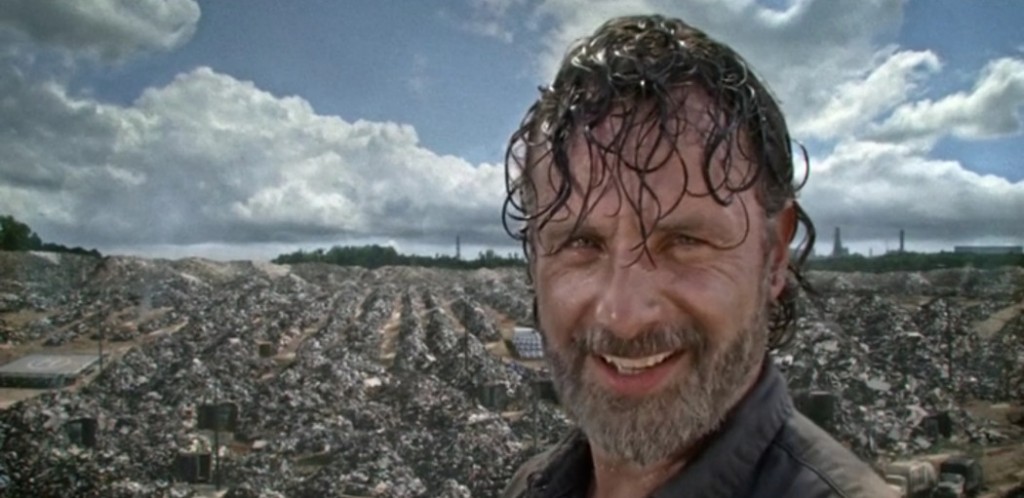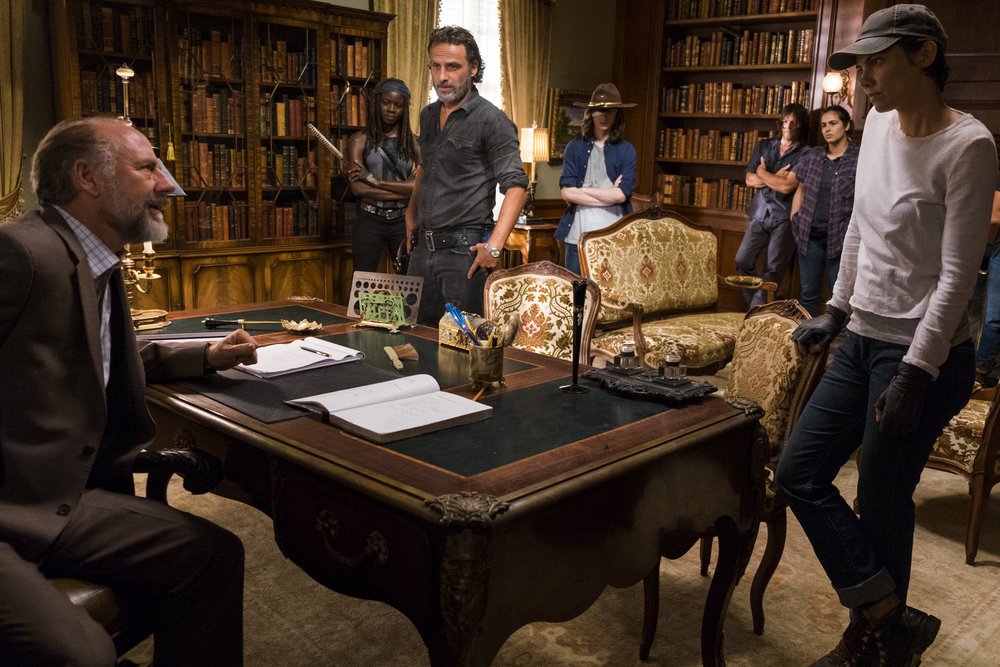-
Recent Posts
- Better Call Saul: There Are No Happy Endings between a “Rock and Hard Place”
- Black Widow Keeps It in the Family for Natasha’s Last Ride
- Loki Finds New Purpose in the Man behind the Mischief
- In its Debut, Star Wars: The Bad Batch Decides Whether to Obey or Rebel
- Nomadland: A Film Out of Time, For Our Times
Archives
Recent Comments
- unblocked games 76 on The Walking Dead: The Division and Reunion in “Hearts Still Beating”
- tombolbet88 link alternatif on The Walking Dead: a Glimpse of the New World in “Knots Untie”
- bali777 login on Veep’s Series Finale and the Hollowness of Getting What You Want
- Ed Clarke on Contact
- Matt on Why “The Frying Game” Is a Dark Horse Contender for The Simpsons’s Worst Episode Ever
Meta
Monthly Archives: February 2017
The Walking Dead Can’t Decide Whether It’s Real or a Cartoon in “New Best Friends”

Realism is always going to be a tricky needle to thread for The Walking Dead. On the one hand, a big part of the show’s claim to fame is the way it takes the well-worn idea of the zombie apocalypse and plays it seriously, sometimes overly seriously. That’s in its DNA. On the other hand, it’s also a show where corpses come back to life, civilians can use weapons like pros with minimal training, and the undead recur in some new obstacle course-like form on a weekly basis. The very premise of the show means that The Walking Dead can’t exactly be as down-to-earth or grounded as its naturalistic aesthetic might suggest, and that’s simply part of the deal.
But sometimes, the series just pushes things too far. The Junkyardigans (my name for the collective that congregates at the dump, at least until an official one is offered) read as silly from the word go. Our heroes have run into plenty of colorful groups before — The Terminites, The Wolves, and the dibs-based biker gang come to mind — but they tend to read as pulpy rather than cheesy. It’s a fine distinction, to be sure, but the difference is that as wild as those groups could seem at times, their outsized characteristics seemed to fit into a certain exaggerated, over the top quality that’s present throughout the series. The Walking Dead isn’t just real; it’s hyper-real, and its more extreme villains and antagonists fit well enough within that atmosphere.
The Walking Dead: Two Good Bits Stand Out in the Doldrums of “Rock in the Road”

The Walking Dead is a frustrating show for a multitude of reasons, not the least of which is that even in an episode like this — one filled to the brim with dull speechifying, blatant wheel-spinning, and lame parables — there’s one or two moments of brilliance that make it hard to just give up on this ever-mercurial series. Even when the show is stalling for time, serving up weak dialogue, or leaning into its weakest tendencies, it sprinkles in a couple of great bits that manage to rise above the rest of the flotsam.
This week, it’s the zombie cheese slicer and Rick’s smile, two dissimilar but connected moments that demonstrate what The Walking Dead is capable of when it’s not tripping over its own bad lines and plot contrivances. Such faults are out in full force in “Rock in the Road,” an episode that sees Rick and the gang at The Hilltop and The Kingdom in an effort to rally forces sufficient to take on The Saviors. The forging of that coalition is inevitable, and the arguments over whether to unite and fight or cling to the status quo have already been turned over by dozens of people dozens of times, which leaves “Rock” with only the thrilling walker-slaying sequence and a brief but clever way to convey Rick’s state of mind to recommend it.
Posted in Television, The Walking Dead
Tagged Episode Reviews, Rick Grimes, The Walking Dead Season 7, Zombies
Leave a comment
Tim Burton’s Batman Is an Evolutionary Step Between Batman ’66 and The Dark Knight Trilogy

Someday, in the not too distant future, we’re going to get a raw, documentary-style Batman film, about a regular guy who just so happens to dress up like a bat and get into ugly fist fights with criminals. And when that happens, we’ll turn around and laugh at how cheesy and unrealistic the Christopher Nolan films seem by comparison. Today’s cultural sensation is tomorrow’s hokey relic. So it goes.
But until that happens, it behooves us to look at Tim Burton’s 1989 Batman film, which scans as corny and even rudimentary relative to Nolan’s Dark Knight Trilogy, with some perspective. After the semi-grounded approach to the character in recent years, it seems odd in hindsight that Burton’s take on the character was praised for its serious approach to the source material. But contemporary critics were comparing it to William Dozier’s Batman ‘66, the overtly comedic, Adam West incarnation of The Caped Crusader. So, as I discussed with Robbie Dorman on the Serial Fanaticist Podcast, while much of Burton’s tack in the 1989 Batman feels broader and even goofier than the Batman of today, his version fits into a wide spectrum of portrayals of the character, on the page and on the screen, that’s taken shape over the last eighty years.
Posted in Movies, Superhero Movies
Tagged Batman, Christopher Nolan, Movie Reviews, The Dark Knight Trilogy, Tim Burton
Leave a comment
Hidden Figures Is a Typical Oscar Movie with an Atypical Focus
You’ve seen Hidden Figures before. Maybe you haven’t seen this exact movie — about how three unduly unheralded African American women helped NASA in the early 1960s — but if, like me, you dutifully watch the slate of Oscar-nominated films year after year, then within ten minutes you’ll already know this movie by heart.
It features a gutsy but unorthodox protagonist trying to make a dent in a system that marginalizes and ignores her. It’s a period piece, with enough obvious dialogue, details, and cameos from well-known historical figures to let the audience know exactly when the story is taking place, with plenty of opportunities for the viewer to say, “My, how far we’ve come.” It has supporting characters facing challenges that mirror the protagonist’s, shining more light on the ways in which the order of the day affected those who were quietly fighting to maintain their place in it. And it has the standard untold story/historical injustice angle, intended to imbue the film with an extra bit of triumph and tragedy, all unleashed with a heavy dose of Hollywood mythmaking.
The difference, and the thing that distinguishes Hidden Figures from the likes of The Imitation Game, Dallas Buyers Club, and other recent Oscar nominees that play in the same space is that it uses the power of that formula in support of a woman of color. At a time when the world of film is still lingering in the shadow of the #OscarsSoWhite controversy, it’s encouraging that Taraji P. Henson is cast as the star of a movie that follows the Oscar-approved blueprint and succeeds at the box office and the awards table in the process. It’s just a shame that the film’s artistic merit can’t match its social merit.
Posted in Movies, Prestige Pictures
Tagged Kevin Costner, Movie Reviews, Oscars, Oscars 2017, Taraji P. Henson
Leave a comment



